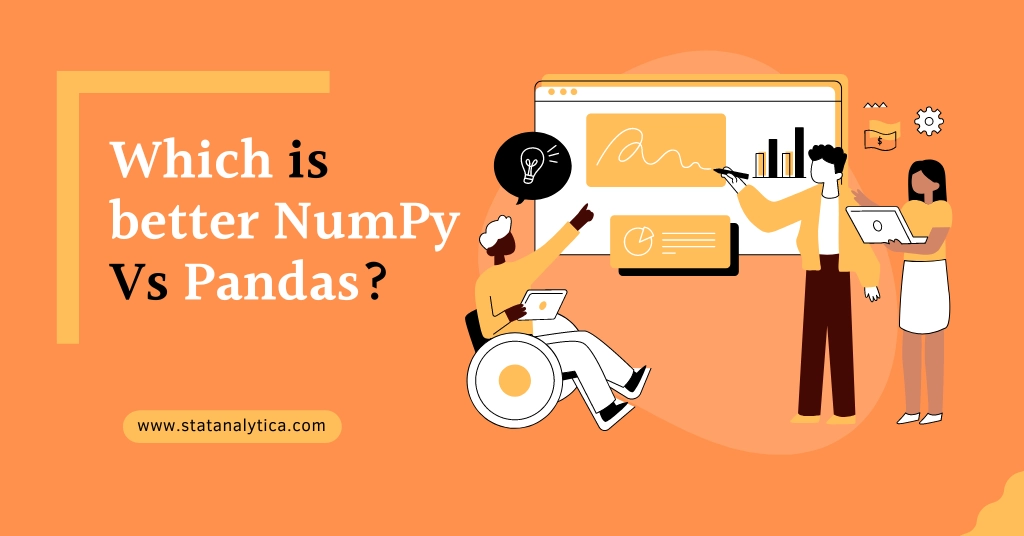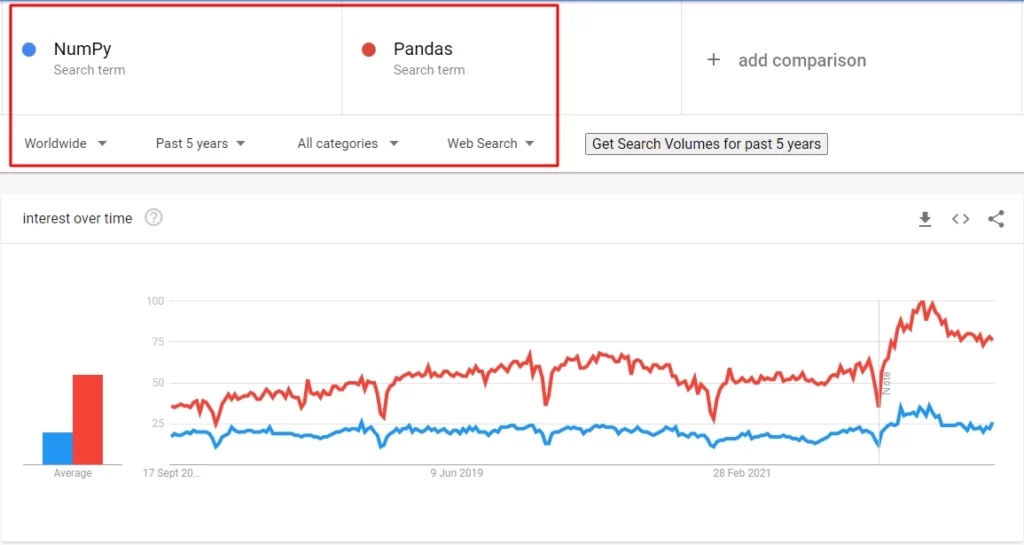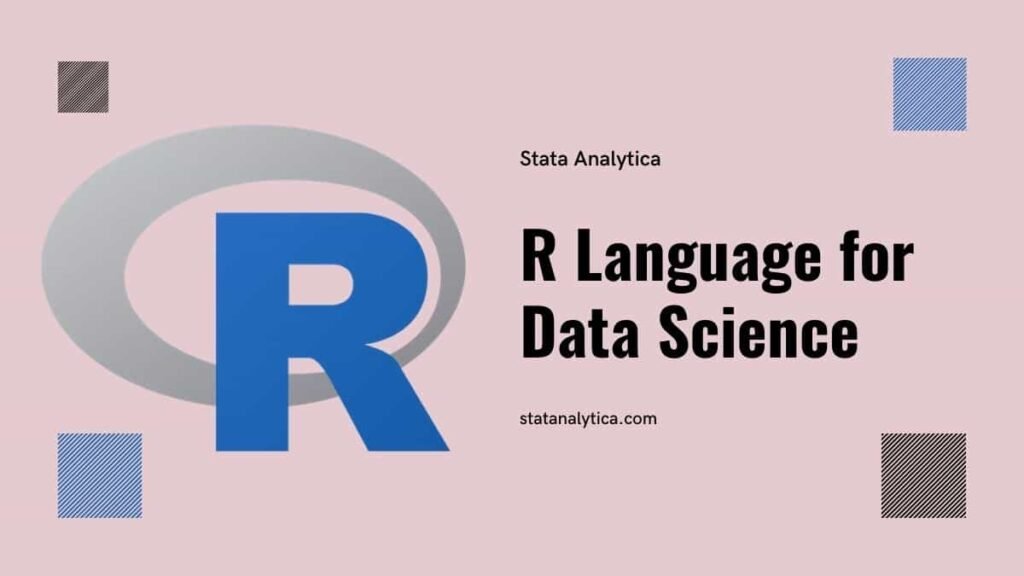One of the world’s most popular general-purpose programming languages is Python. If you are in the IT sector, then you must be familiar with Python. On the other hand, there are multiple reasons why it has become so popular in many fields, like software engineering, data science, machine learning, and many more. However, the main reason Python has become this popular is that it is rich in libraries. Among these libraries, the two most commonly used Python libraries are Numpy and Pandas. That is why many of you are wondering and want to know more about NumPy vs Pandas. If so, then you are at the right spot. In this blog, we will discuss the difference between Numpy vs Pandas.
So, without wasting any time, let’s get straight into the action, but first, let’s know what is Numpy and Pandas.
What is Numpy?
Table of Contents
NumPy was created in 2005 by Travis Oliphant. It is an open-source and free-of-cost library, which means you can use it from anywhere in the world. Another powerful Python software library, which has been in use in the last couple of years, is NumPy. However, as per the official site, NumPy is “the fundamental package for scientific computing with Python.”
You can easily perform operations on big, multi-dimensional arrays and matrices by using NumPy. Moreover, NumPy also provides us with an enormous collection of high-level mathematical functions, for instance, the sin() function, the sort() function, etc., to operate on these arrays and their elements.
On the other hand, NumPy is a python library used for working with an array. Which includes logical, mathematical, statistical operations, sorting, selecting, I/O, discrete Fourier transforms, basic linear algebra, random simulation, and many more.
Key Features of Numpy Library:
- NumPy library uses a homogenous data type.
- This library helps to build data objects with multiple dimensions.
- It also provides robust matrix manipulation methods.
- NumPy library helps to broadcast the applied operations.
- It consists of various other packages, such as Matplotlib, Seaborn, etc. Which can make your work more easier.
- NumPy is a universal data structure in OpenCV for filtering images, kernels, etc.
What is Pandas?
Wes McKinney developed pandas in 2008. Pandas is one of Python’s most popular software libraries. It can be used for data manipulation and analytics as it provides extended data structures to hold different types of labeled and relational data. On the other hand, it also allows many operations like joining, merging, concatenating data, and reshaping.
The term “Pandas” comes from the term “Panel Data.” Moreover, Panel Data is a term that describes data sets that include observations over several periods for the same individuals. Several languages are used to write Pandas, including Cython, Python, and C. Pandas support importing data from several file formats, including JSON, SQL, Microsoft Excel, etc.
It has been built on top of the NumPy package of Python, so NumPy is a dependency of Pandas. As a result, Pandas cannot be used without NumPy. On the other hand, it is released under the three-clause BSD license. Pandas have a variety of data structures and operations to offer to manipulate numerical tables and time series.
Key Features of Pandas Library:
- Pandas is the most famous python library that helps deal with integrated indexing.
- It helps to pivot the datasets.
- Pandas library includes tools for writing and reading data in-memory data structures as well as multiple file formats.
- The main feature of Pandas is that it enables you to join and merge various datasets.
- It enables handling the data alignment and missing data.
- Pandas library also supports hierarchical axis indexing for converting high-dimensional data into lower-dimensional data.
14+ Difference Between NumPy vs Pandas: In Tabular Form
| Parameter | NumPy | Pandas |
| Memory Consumption | NumPy is memory efficient than Pandas | Whereas, Pandas consume more memory |
| Data Compatibility | Works with numerical data | Works with tabular data |
| Powerful Tool | Arrays are the powerful tool of NumPy | Whereas, Data frames are a powerful tool for Pandas |
| Speed | Faster than data frames | Relatively slower than arrays |
| Performance | NumPy performs better when the number of rows is 50K or fewer | Pandas perform better when the number of rows is 500k or more. |
| Type of Data | Homogenous data type | Heterogenous data type |
| Application | NumPy is popular for numerical calculations | While Pandas is popular for data analysis and visualization |
| Operations | NumPy does not have any additional functions | Whereas, Pandas provide special utilities such as “groupby” to manipulate and access subsets |
| Industrial Coverage | NumPy is mentioned in 62 company stacks and 32 developers’ stack | Whereas, Pandas are mentioned in 73 company stacks, and 46 developers’ stack |
| Data Object | Creates “N” dimensional objects | Creates “2D” objects |
| Access Methods | Using only index position | Using index position or index labels |
| Indexing | If we talk about indexing, then indexing in NumPy arrays is very fast | On the other hand, indexing in the Pandas series is very slow |
| Core Language | NumPy was written in C programming when it was initially created | Pandas use R language for reference language |
| Usage in ML and AI | Scikit and TensorFlow and can only be fed using NumPy arrays | On the other hand, Pandas series cannot be directly fed as input toolkits |
| External Da | NumPy generally uses data created by the user or a built-in function | On the other hand, pandas objects are created by external data such as CSV, Excel, or SQL |
Read More:
Which is better NumPy Vs Pandas?

As you can see from the above table, NumPy is more memory efficient than Pandas. It helps to work on the “N” dimensional data structure, which gives it a better performance over Pandas data frames. When it comes to working in data science, the NumPy library possesses multiple toolkits, such as Tensorflow and Seaborn, which can be fed to the models, unlike Pandas. NumPy is also relatively faster than the Pandas series as it takes much time to index the data frames.
Pandas have their importance as the python library, but looking at all the above advantages offered by NumPy, the conclusion is that NumPy is better than Pandas. But that doesn’t mean that Numpy is always better than Pandas. It depends on the user’s need. On the other hand, we also compare both the libraries in google trends let’s see which is better in that scenario.
Google Trends: Numpy Vs Pandas
Below is the comparison graph of NumPy vs Pandas. However, the NumPy is in blue, and the Pandas is in red.

As you can see, the search term for “NumPy” is unsteady and below pandas. On the other hand, Pandas have been gaining interest from people for the past 5 years. If we talk about which is better in terms of Google search, then the clear winner of this round is Pandas, but if we talk about features, then the clear answer is NumPy without any doubt.
Conclusion
This is the end of the blog, NumPy vs pandas. So, in conclusion, we can say that Pandas has been built on top of NumPy. On the other hand, both Python libraries have significant differences. Pandas and NumPy simplify matrix multiplication and are heavily used in data science and machine learning.
Hence, we recommend this library to all today’s new programmers who want to learn these libraries to become machine learning, data science, researchers, or machine learning practitioners. As a result, this will not only open gates for them to grab a job at some of the biggest IT companies in the world but also help them in their day-to-day calculations to become good Data Science and Machine Learning experts.
FAQs
Q1. Is NumPy faster than Pandas?
If we talk about which one is faster, then indexing in NumPy arrays is very fast. On the other hand, indexing in the Pandas series is very slow. As a result, NumPy is way faster than Pandas.
Q2. Is Pandas same as NumPy?
Like NumPy, Pandas is one of the world’s most widely used Python libraries in data science. On the other hand, it provides data analysis tools and high-performance, easy-to-use structures, unlike the NumPy library, which provides objects for multi-dimensional arrays. However, Pandas provides an in-memory 2D table object called a Dataframe.


